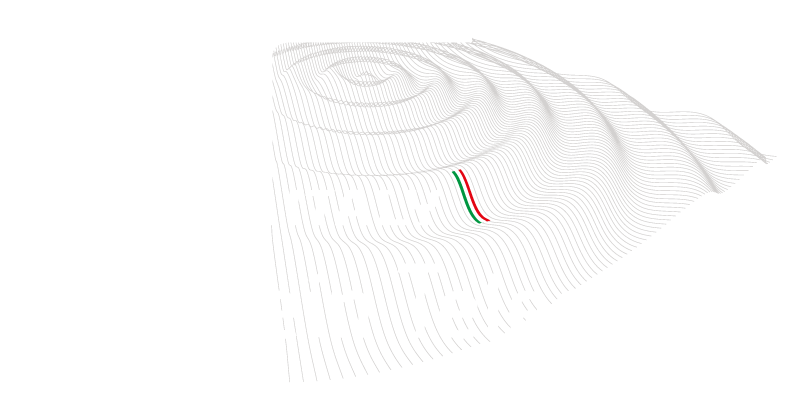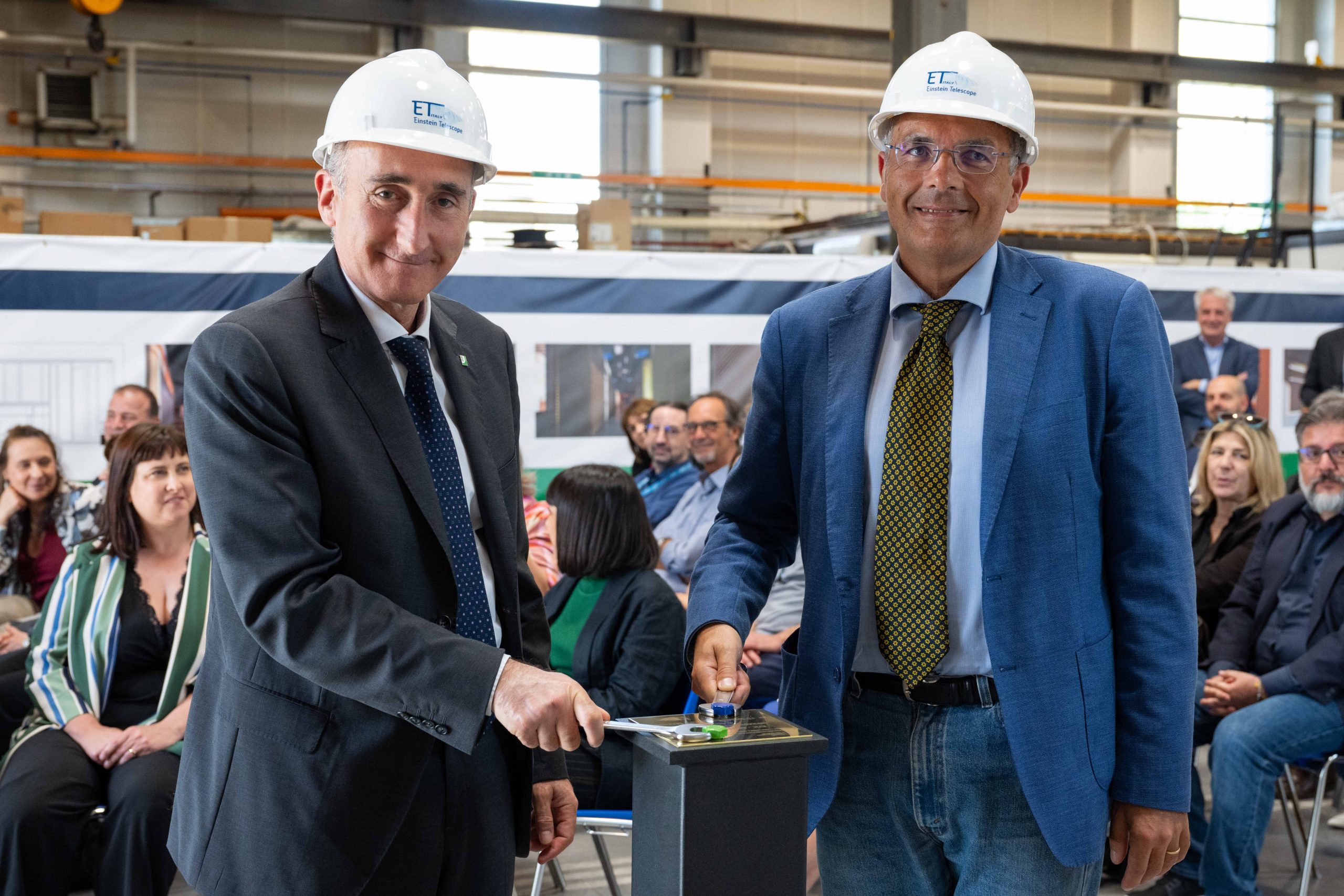Source: University of Rome Tor Vergata/INFN, 04/06/24
On Friday, May 31st, the groundbreaking ceremony for the advanced optics laboratory “AiLoV-ET” took place in the PP1 building of the Macro Area of Sciences MM. FF. NN. at the University of Rome Tor Vergata. The name AiLoV-ET encapsulates a strong commitment to a highly significant scientific project: the Einstein Telescope. The event was attended by Nathan Levialdi Ghiron, Rector of the University of Rome Tor Vergata, Marco Pallavicini, vice president of the National Institute for Nuclear Physics (INFN), Michele Punturo, scientific coordinator of the ETIC project and international head of the Einstein Telescope collaboration, Pasquale Mazzotta, director of the physics department at the University of Rome Tor Vergata, and Viviana Fafone, professor of physics at the physics department at Rome Tor Vergata and head of the emerging AiLoV-ET laboratory.
The Einstein Telescope is a fundamental research project with a primary and prioritized mission focused on science: its goal is to study the universe through gravitational waves, exploring its history to understand its origins, formation, evolution, and future. This instrument is so named because it will “observe” gravitational waves that reach Earth from deep space, whose existence was first hypothesized by Albert Einstein as a consequence of his theory of general relativity. ET, however, will be more about “listening” to the universe, as gravitational waves are like the voice, the echo, of the most extreme astrophysical events happening in the cosmos, such as the collisions of black holes or neutron stars, or supernova explosions. Einstein Telescope is one of the largest and most ambitious projects on the ESFRI (European Strategy Forum on Research Infrastructure) roadmap, and Italy has put forward Sardinia as its proposed host site.
The ETIC – Einstein Telescope Infrastructure Consortium is the consortium established and funded under Mission 4 coordinated by the Ministry of University and Research (MUR) as part of the National Recovery and Resilience Plan (NRRP), with INFN as the lead partner. The aim of ETIC is to support Italy’s candidacy to host the most innovative gravitational telescope ever designed in Sardinia, in the disused Sos Enattos mine in the province of Nuoro.
Once completed, AiLoV-ET, one of the laboratories being developed under ETIC, will contribute to the technological development of the Einstein Telescope. Researchers from the physics department and the INFN-Tor Vergata section, led by Professor Fafone, will be among those working in this lab.
The laboratory will be housed in the historic building constructed by Rome Tor Vergata in the late 1980s, which has hosted many experiments in collaboration with INFN. Currently, it supports major projects such as ATLAS, JLAB12, and Virgo.
“The AiLoV-ET laboratory at the physics department of the University of Rome Tor Vergata is a new piece of the great mosaic we aim to build in Italy for gravitational wave research,” comments Marco Pallavicini, vice president of INFN. “Italy has a long and prestigious tradition in this field: there are only two countries in the world equipped with instruments capable of detecting gravitational waves, the United States and Italy, thanks to the Virgo detector. Now, the future is the Einstein Telescope, an infrastructure we hope to build in Italy, in Sardinia, and for this, we are working as a scientific community and as a country with significant government commitment. In this context, AiLoV-ET will contribute to the Italian bid and the project by developing cutting-edge technologies to shape the future of one of the most promising areas of scientific research,” concludes Pallavicini.
“The collaboration between our physics department and INFN is historic,” confirms Nathan Levialdi Ghiron, Rector of the University of Rome Tor Vergata, “and today’s event with the laying of the first stone of the advanced optics laboratory is in synergy with the deep relationship with our institutions, related to specific research activities and the creation of physical infrastructures that can lead to very interesting and important developments”.
“I am very proud that the University of Rome Tor Vergata is participating in this ambitious project and I am confident that our laboratory will make a significant contribution to all the research activities to be developed, utilizing the skills of our current and future researchers, who will have the opportunity to refine, develop their activities, and also enhance their growth and promote their research activities.”
“To realize the Einstein Telescope, we need to push the technologies developed for Virgo to the limit, but also to develop new technologies that do not yet exist,” explains Michele Punturo, scientific coordinator of ETIC and the international Einstein Telescope scientific collaboration. “For example, in the field of advanced optics, where the AiLoV-ET laboratory will be engaged, we do not yet have the technologies that will enable the Einstein Telescope to reach its design sensitivity and explore a volume of the universe at least a thousand times greater than what we can study today with current instruments. These technologies will be developed here and in other labs in the network we are building, thanks to the resources provided by the NRRP for the ETIC project. The Einstein Telescope is a long-term endeavor, in which young researchers, many of whom we have been able to involve thanks to NRRP funds, will play a fundamental role from now and for years to come,” concludes Punturo.
“This is an important day for Tor Vergata,” begins Viviana Fafone, professor of physics at the physics department at Rome Tor Vergata and head of the emerging AiLoV-ET laboratory, “which has a long tradition in gravitational wave research, since its founding with Professor Modena, and in subsequent years with Professor Pizzella, who initiated gravitational wave research in Italy and worldwide”.
“Now there is the Einstein Telescope, and we are proud that this laboratory will contribute to the technological developments for the most innovative gravitational telescope ever designed. We have named our laboratory AiLoV-ET, which means Advanced optics Lab at Tor Vergata for ET: a name that, on one hand, expresses the deep involvement that the research group has always dedicated to gravitational waves, and on the other, recalls the development themes that will be the focus of the laboratory’s activities”. Fafone illustrates the main activities of the future laboratory: “We will work on the heart of the interferometer, the ET mirrors, which are truly at the forefront of technology: we do not yet know how to make them and will focus research on new materials. Moreover, we will work on another important aspect: the correction of optical defects to minimize the impact of the infinitesimal but inevitable imperfections that would otherwise compromise the sensitivity of the instrument. This is our mission: there is much work to be done, but much has already been accomplished, and we are here today thanks to a tremendous team effort”.
Featured image: Nathan Levialdi Ghiron and Marco Pallavicini (credits: University of Rome Tor Vergata)

